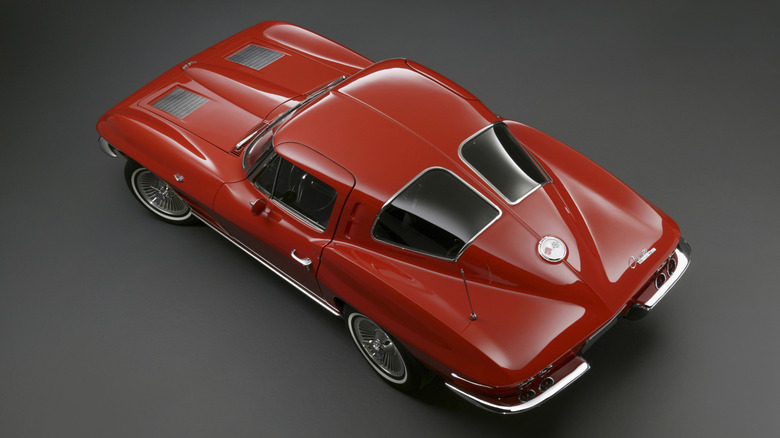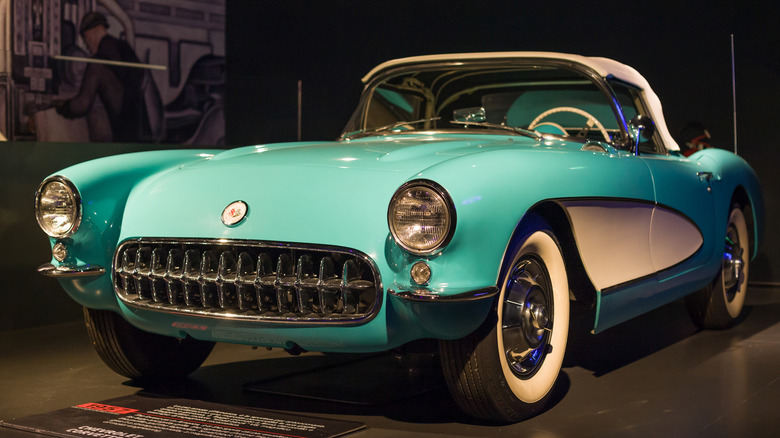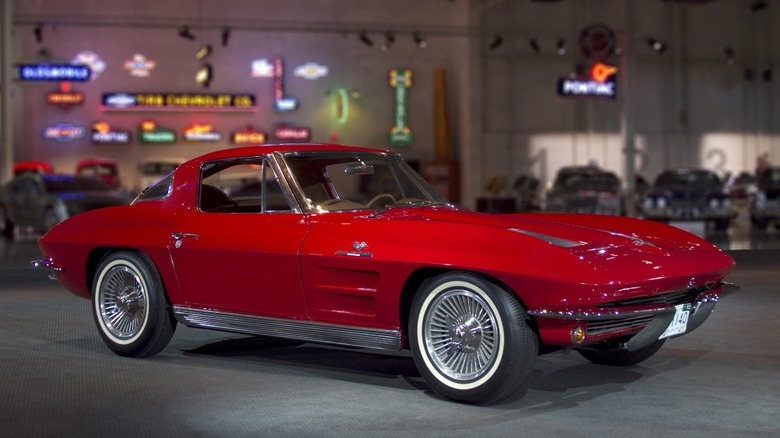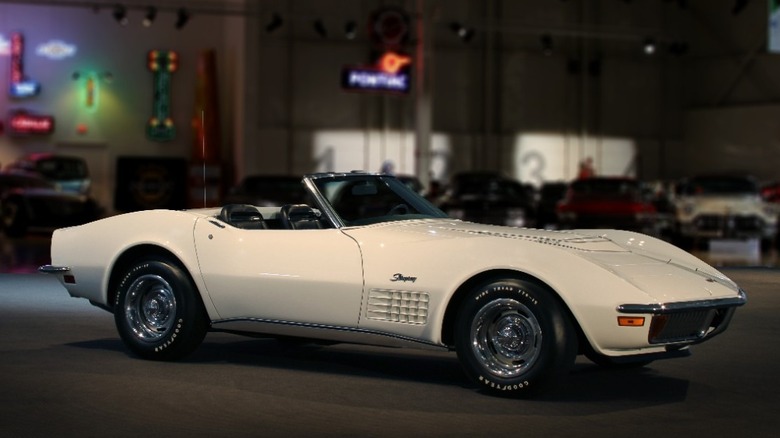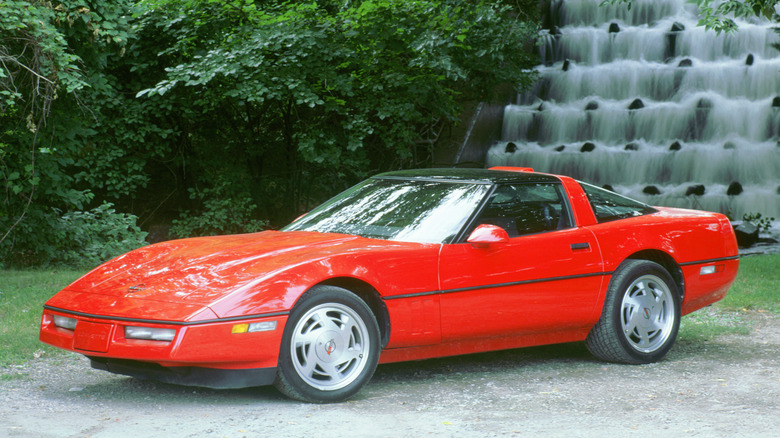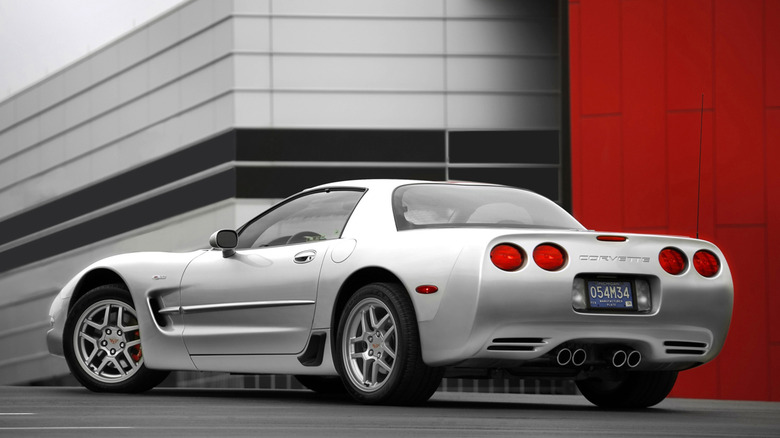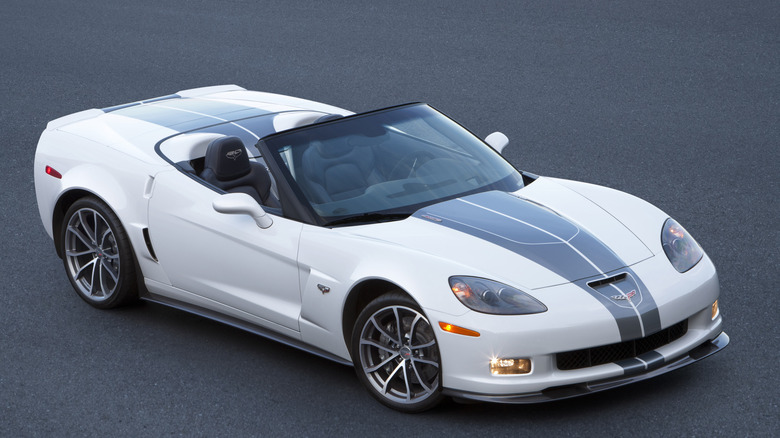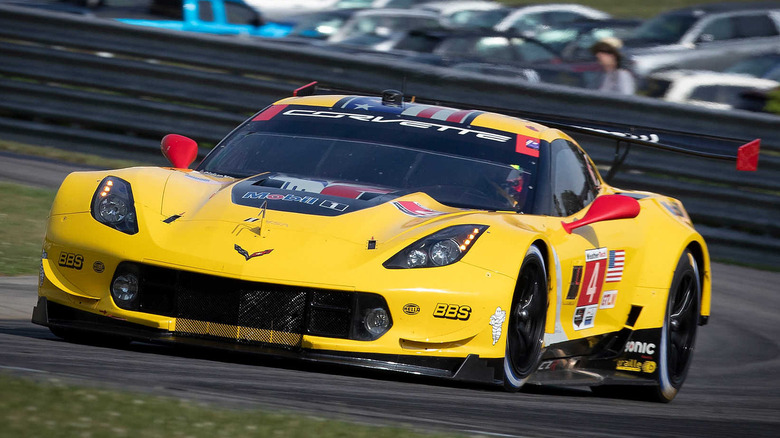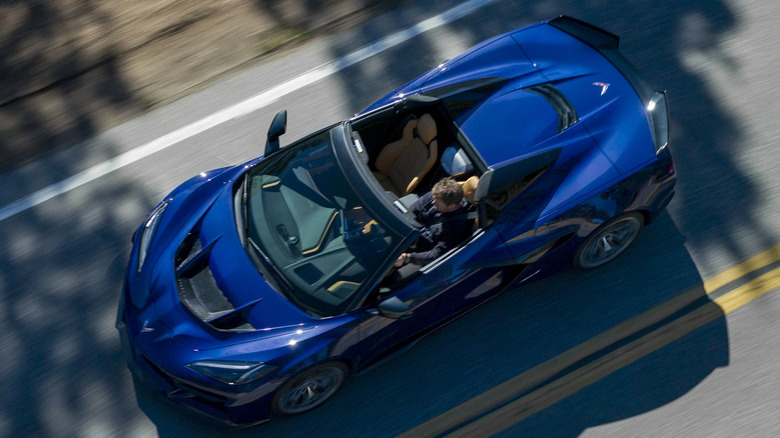8 Of The Best-Looking Corvettes Ever Designed By Chevrolet
Picking the best-looking Corvettes ever designed by Chevrolet is a very enjoyable exercise, given that there are many examples of America's Sports Car that are pleasant to gaze upon. During the 71 years that the Chevrolet Corvette has been in production, Chevy has made a wide variety of Corvettes for us to drool over — from concept cars to racing cars to limited editions to super high-performance street cars. That's more than seven decades of standout cars that appeal to our desire to see how far the next 'Vette will push the envelope.
With that in mind, what follows is eight Corvettes that represent the brand's unique blend of cutting-edge styling with performance-enhancing powertrains under the hood. These vehicles represent significant milestones that show how the Corvette has evolved into an attractive and capable sports car that gets respect not just in the U.S., but around the world. Here are SlashGear's picks of the best-looking Corvettes.
1957 Corvette Convertible
Our first pick is the 1957 'Vette, the last year of single headlights, giving its fiberglass body a Ferrari-esque look. From 1958 on, the Corvette would adopt the smaller but wider quad headlights that became all the rage for a while. The 1957 Corvette had advanced from the original 1953 version to the point where it had ditched the side curtains for roll-up windows, and it had also added outside door handles. It was becoming a real car. All 6,339 Corvettes made in 1957 were convertibles, although a lightweight hardtop was available.
1957 was also the year that Ramjet fuel injection became an option on the Corvette's 283 cubic-inch V8. When the three-speed manual transmission was specified (a four-speed became available late in the model year), the 1957 Corvette had an output of 283 horsepower, or one horsepower per cubic inch. This was accomplished through the use of a special camshaft, 10.5:1 compression ratio, and solid lifters. Zero-to-60 mph times as low as 5.7 seconds have been recorded (using the highest numerical rear axle ratio) — excellent for a street car in 1957!
1963 Corvette Sting Ray Coupe
The 1963 Corvette Sting Ray Coupe, one of the most beautiful Chevrolet models ever sold at auction, is a unique beauty because of its one-year-only split-rear-window design. The split rear window, created by GM designer Bill Mitchell, was very distinctive from the outside and permitted the use of a central "spine" that ran the length of the roof, mimicking the spine of an actual sting ray.
Unfortunately, Sting Ray owners did not appreciate their rear view being blocked and after many complaints, a one-piece rear window was added for all succeeding years of this coupe's production. The rarity of the split window has made the 1963 coupes very desirable.
This was the first Corvette coupe, which was produced in addition to the convertible. The 1963 production numbers amounted to 10,594 coupes and 10,919 convertibles.
As the initial year of the 1963-67 Corvette, the 1963 Sting Ray came with a new fully independent suspension, which transformed the Corvette's handling. The ladder-type frame was also new, and allowed the Corvette's center of gravity to be lowered by two inches.
Drum brakes were the only type offered, with discs not arriving until the 1965 model year. The four engine options were all variations on the Chevy 327 cubic-inch small block, with outputs including 250, 300, and 340 four-barrel carbureted horsepower plus the top dog 360-horsepower fuel-injected mill.
1970-72 Corvette ZR-1 Convertible
This Corvette was modeled on the Mako Shark II show car, also known internally as XP-830. The Mako Shark II, which first showcased this car's dominant fenders and narrowed waist, appeared in April 1965 at the New York International Auto Show. This is a part of everything Chevy fans should know about the C3 Corvette.
This particular Corvette combines the convertible body with the pre-1973 chrome bumpers, giving it a trimmer appearance. From 1973 on, larger body-colored bumpers that met the newly enacted impact-absorbing bumper regulations were used. These made the car look longer and heavier, which it actually was.
Mechanically speaking, new for 1970 was the RPO ZR1 option, which dropped the LT-1 high-output small block engine into your Corvette. Based on the 350 cubic-inch V8, the LT-1 used an 11:1 compression ratio, solid lifters, special camshaft and exhaust system, and an aluminum intake manifold topped with a Holley four-barrel carb under a domed hood to generate 370 horsepower.
The ZR1 option also added a heavy-duty four-speed transmission, transistorized ignition, special radiator, and revised suspension. The LT-1 engine continued through 1972, but its power was downgraded due to tightening emissions regulations, lowered compression ratios due to a requirement that engines run on lower-octane gasoline, and GM's move to lower net horsepower ratings.
1990-95 Corvette ZR-1 Coupe
The 1990-95 Corvette ZR-1 Coupe is special not because of its truly spectacular engine, but because of the design changes required to manage its formidable horsepower. The ZR-1, which some consider to be the best version of the worst Corvette, has different doors and rear section than other C4s. Because of the 11-inch-wide rear wheels and super-wide 315-section tires needed, the rear section of the ZR-1 was around three inches wider than that of the standard C4 Corvette. It was also concave instead of convex in contour, and housed unique square taillights compared to the standard car's round ones (although the standard car got the square lights later). Rectangular exhaust outlets completed the look.
The real reason for the 1990-95 Corvette ZR-1 Coupe's appearance is the Lotus-developed, all-aluminum, 32-valve DOHC engine under the hood. This highly sophisticated engine initially put out 375 horsepower (and was upgraded to 405 hp in 1993).
The ZR-1 put down a zero-to-60 mph time of 4.4 seconds, a quarter-mile time of 12.8 seconds at 113.8 mph, and pulled .98 g's on the skidpad — pretty good for 1990! A total of 6,939 units of the Corvette ZR-1 were produced between 1990 and 1995.
2001-04 Corvette Z06 Notchback Coupe
The 2001-04 Corvette Z06 Notchback Coupe is one of the best-looking Corvettes because it is a perfect example of form following function. While the lighter, trimmer, and more rigid "hardtop" body style was initially offered on standard Corvettes as a lower-cost option in 1999 and 2000, it became the exclusive property of the Z06 models from their 2001 debut through the end of the car's run in 2004. The Z06's mission was simply to be the best-performing Corvette available direct from the factory at that point.
The Corvette Z06 Notchback Coupe, one of the higher-ranked generations of the Chevy Corvette, featured a 5.7-liter LS6 small-block V8 that had several upgrades from the standard LS1 mill. The LS6 had higher compression and more aggressive valve timing, along with improved intake and exhaust manifolds. The Z06's horsepower rating was 385 in 2001, increasing to 405 for the 2002 to 2004 model years.
Supporting the engine performance of the Z06 was a firmer suspension setup, grippier tires, and brake ducts to cool things down during aggressive driving (which the Z06 encouraged). Firm brakes confirm the Z06's high-performance intent.
2013 Corvette 427 Convertible
The 2013 Corvette 427 Convertible, representing one of the best years of the C6 Corvette, was a distinct model that commemorated the 60th Anniversary of the Corvette. The 427 Convertible pictured above wears the 60th Anniversary package, which includes arctic white exterior with racing stripes in pearl silver blue, diamond blue leather wrapped interior, blue top, a ZR1 rear spoiler, gray brake calipers, plus 60th anniversary badging and embroidery.
In terms of specifications, it is the closest that you could come to a Z06 convertible. The Corvette 427 Convertible has the same 7.0-liter engine, bumped up to 512 horsepower. It wears the same carbon-fiber fenders and hood as the Z06. It has the same magnetorheological shocks, the same Michelin Pilot Sport tires, the same rear axle, and the same brakes as the Z06. The 2013 Corvette 427 Convertible has a zero-to-60 time of 3.9 seconds, a top speed of 182 mph, and can corner on a skidpad at 1.03 g.
2014-19 Corvette C7.R race car
The 2014-19 Corvette C7.R race car was the Corvette standard-bearer for its factory-backed Corvette Racing efforts. In terms of looks, it is the lowest, widest, and meanest manifestation of the Corvette, going way beyond the badass looks of even the 2019 Corvette ZR1. The Corvette C7.R is obviously a performance-focused evolution of the street version, taken to an extreme that is limited only by the racing rulebook. Form follows function!
The C7.R, built by Pratt and Miller, is powered by a naturally aspirated, 5.5-liter engine known as the LS5.5-R. While the LS5.5-R is ultimately capable of producing 750 horsepower, the need to comply with the FIA/ACO's Balance of Performance regulations, as well as maintain reliability and achieve good fuel economy, kept its output around 493 horsepower. This power traveled to the rear wheels through a six-speed sequential Xtrac transmission controlled by paddle shifters.
The 2014-19 Corvette C7.R, built as seven different racing chassis, generated numerous racing victories for Chevrolet. These included a total of 17 wins (including four during its first season), the team and driver championships in 2016, 2017, and 2018, and the manufacturer championships in 2016 and 2017. Corvette Racing also won the 2015 endurance racing triple crown for its wins at Daytona, Sebring, and Le Mans. A limited-edition street version (only 650 in total) of the C7.R was produced for the 2016 model year.
2025 Corvette ZR1 Convertible
The 2025 Corvette ZR1 Convertible is a great-looking car with one of the most powerful flat-plane V8s and performance that just won't quit. What could be better than cruising in this beauty with the top down and having 1,064 horsepower right behind your shoulder blades, ready to propel you into another dimension?
The fact that a ZR1 Convertible actually exists shows that the Corvette engineers have a sense of humor. Its flat-plane, twin-turbo, 5.5-liter V8 engine can get through the quarter-mile in under 10 seconds, while a ZR1 recently hit a top speed of 233 mph on a high-speed oval in Papenburg, Germany. As the apex predator of the Corvette ecosystem, the ZR1 has nothing left to prove. It should be able to hold its own in any confrontation with competing supercars.
One of the big questions at this point is how much will it cost? Estimates have ranged from $150,000 to $200,000, and that's before you add any options plus the inevitable dealer markup that goes on top. Bring lots of money!
